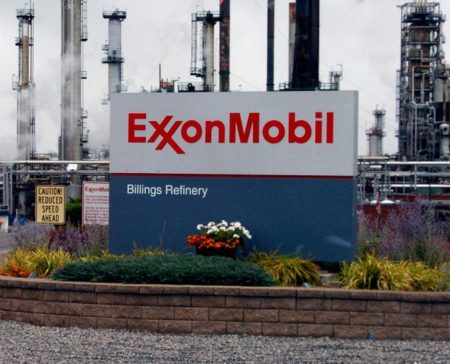May 15, 2019 – A document entitled CO2 “Greenhouse” Effect, A Technical Review, Prepared by the Coordination and Planning Division, Exxon Research and Engineering Company, April 1, 1982, which is accompanied by a covering letter authored by Marvin B. Glaser, Manager of Environmental Affairs Programs, and dated November 12, 1982, begins stating:
“The material has been given wide circulation to Exxon management and is intended to familiarize Exxon personnel with the subject. It may be used as a basis for discussing the issue with outsiders as may be appropriate. However, it should be restricted to Exxon personnel and not distributed externally.”
The technical review which follows includes a summary which begins by noting that the previous 25 years before 1982 have seen an 8% rise in atmospheric CO2 to 340 parts per million, “a trend which began in the middle of the last century with the start of the Industrial Revolution.”
It goes on to further state that “The carbon dioxide content of the atmosphere is of concern since it can affect global climate.” It estimates a doubling of CO2 content to occur “around the year 2090 based upon fossil fuel requirements projected in Exxon’s long-range energy outlook.”
It goes on stating “Our best estimate is that doubling of the current concentration could increase average global temperature by about 1.3 Celsius to 3.1 Celsius. The increase would not be uniform over the earth’s surface with the polar caps likely to see temperature increases on the order of 10 Celsius and the equator little, if any, increase.”
the summary says that the warming of the atmosphere and earth would likely not be detectable before 1995 “when the temperature might rise the 0.5 Celsius needed to get beyond the range of normal temperature fluctuations.” And further along, it states substantial climatic changes wouldn’t be evident until global average temperatures rose by 1 Celsius above the levels of 1982.
And here’s its logical conclusion based on the evidence, and stated very clearly:
“Mitigation of the ‘greenhouse effect’ would require major reductions in fossil fuel combustion.”
But Exxon executives need not worry because “potentially serious climate problems are not likely to occur until the late 21st century or perhaps beyond at projected energy demand rates.”
So doing something “would be premature in view of the severe impact such moves could have on the world’s economies and societies.”
What is not stated is the impact on Exxon’s business model and bottom line. And since the report and covering letter acknowledge widespread distribution to Exxon’s management at the time it should be interesting to see what was being said publicly.
The answer to that in 1982 in the aftermath of the disclosure of this report to internal Exxon staff is nothing. That’s right, no Exxon employee publicly went on record, or discussed the issue with the governments of the time, about what the company’s research and engineering arm had discovered. Instead in a 1988 memo, Joseph M. Carlson, a spokesperson for the company wrote of the company’s strategy to “emphasize the uncertainty in scientific conclusions regarding the potential enhanced Greenhouse effect.”
Why would that be the position of choice? Because in his talking points he states, “resist the overstatement and sensationalization of potential Greenhouse effect which could lead to noneconomic development of nonfossil fuel resources.”
In 1997, Lee R. Raymond, Chairman and CEO, at a World Petroleum Congress told his audience of fossil fuel producers and government officials in light of the imminent signing of the Kyoto Protocol agreement by 160 nations:
“Many people – politicians and the public alike – believe that global warming is a rock-solid certainty. But it’s not.” He went on to address three questions:
“Is the Earth really warming?”
“Does burning fossil fuels cause global warming?”
“And do we now have reasonable scientific basis for predicting future temperature?”
To diminish the warming argument he pointed to the Ice Ages of the Pleistocene. Then he went on to suggest if the temperature is rising that the greenhouse effect was likely from natural sources “especially water vapor.” And then he trashed the science of prediction saying the models have such wide latitude in temperature variation that it makes it impossible to believe in their certainty.
To this casting doubt strategy, he then added fear, fear that politicians would regulate the oil and gas industry to reduce emissions leading to “energy rationing administered by a vast international bureaucracy responsible to no one.” You have to admit, he was pushing all the right buttons threatening capitalism, the free market, with a world government bureaucracy applying “punishing, high energy taxes.”
He concluded calling for “an open debate on the science, an analysis of the risks, and a careful consideration of the costs and benefits.”
And what is the CEO and Chairman of Exxon Mobil, the current iteration of the company saying today?
Recently, Exxon Mobil and two other U.S. energy producers joined the Oil and Gas Climate Initiative, (OGCI) which was launched in 2014 and currently includes 13 oil and gas companies as members. In announcing its participation, Exxon Chairman and CEO Darren Woods stated:
“It will take the collective efforts of many in the energy industry and society to develop scalable, affordable solutions that will be needed to address the risks of climate change.”
In his statement, he is not exactly providing a full-throated commitment to a low-carbon economic future, and neither are the other members of OGCI who have stated these three objectives:
- Influence the broader energy industry to reduce its global carbon footprint with a caveat. It must take place across the entire energy sector to be of substance which means getting downstream players, joint venture partners, utilities and energy-intensive industries to work together.
- Accelerate the policy agenda for further public sector action such as procuring clean products, investing in carbon capture, use, and storage infrastructure, developing natural sinks, and committing financial and human resources from governments at all levels including the United Nations.
- Link climate change strategy closely with sustainable development goals because action will only happen within a global context that leverages innovation to reduce poverty and spread prosperity.
So here we are in 2019 with 37 years having passed and a mounting climate challenge that the world’s largest oil company knew was going to happen back then and chose to lie about it until now.
















